When it comes to linear measurements, it means length, width, height, thickness, depth, diagonal, diameter, etc. It is about the straight or shortest distance between two points.
Length is one of the most measured linear distances. Tools to measure length have been existing from the beginning of humanity. People utilized fingers to measure short length and steps to measure farther length. Through advanced technology, we empower resources to invent better tools for more accurate and precise measurements.
There are actually different tools to measure length. Each length measuring tools typically serve different kinds of range. The tool to measure the length of a building is different from the tool to measure the distance of a deer you are going to shot.
You’ll never find a one-fits-all length measuring device in a tool.
There are a lot of other measuring tools to measure linear distance. And this post will cover that topic. So far, we successfully break down these 18 linear measurement tools that we commonly use.
1. Ruler

Rulers are the most often used length measurement tool that we find in workshops, offices, schools, and homes. It can measure with a typical resolution of 1 millimeter.
A precision metal ruler is important in workshops. It can check the graduation accuracy of the tape measure and other tools that come with ruler feature. It’s not only for measuring but also for marking and scribing.
Looking for the best ruler? Read our article about it here. If you need a more precise ruler, go to the precision ruler.
2. Yardstick or Meter Stick
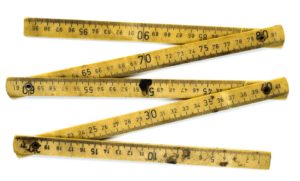
Its length is generally 1 meter. So whenever a ruler is not convenient to help you measure a length, then your option should be the meter stick. The vast majority of the meter stick is made of wood. Similar to the ruler, its precision is about 1 millimeter; and the scale is available in metric and imperial as well.
3. Tape Measure
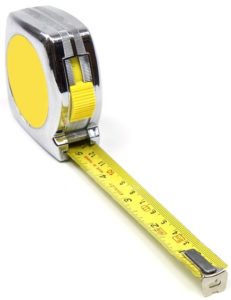
A tape measure is a portable compact flexible ruler that can be rolled up and pull out. This is an important tool to measure a length that is more than 1 meter and up to 100 feet. For instance, a tape measure for surveyors is able to quantify distance up to 100 feet.
There are some types of tape measures you need to know: sewing tape measure, retractable tape measure, and surveying tape measure. The tape measure should be your choice when working in the field of carpentry, construction, surveying, sewing, engineering, etc. It has a good resolution which you’ll find some of them graduated with even 1/36 inch increment. But, in most cases, you’ll find its scale similar to rulers.
4. Laser Measure
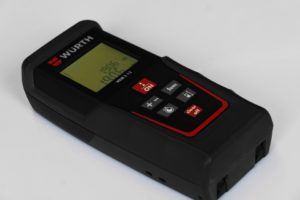
You can easily measure distance, displacement, area, and even volume by empowering a laser. The laser measure is a linear measurement tool that is by means of not touching the object physically; not like a tape measure that needs to stick out the blade onto the surface of something being measured. Having that said, your work is highly simplified, and becomes easier and faster. Today, laser measure is one of the products of useful technology that is commonly used by technicians, appraisers, engineers, etc. Its high precision, speed, and simplicity are exceptional features that laser measure has.
5. Gauge Block
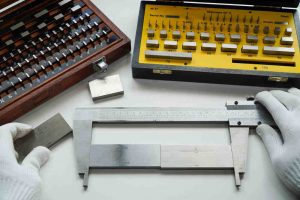 This is made of steel or carbide or ceramic block that is used for calibrating a linear (length, width, thickness, depth, and height) measuring instrument. If you are going to calibrate calipers and micrometers, then you have to use a block gauge. This is a stretch-and-contraction-resistant block that provides high accuracy against the temperature change of the circumstance. A gauge block is commonly made of low thermal coefficient material to sustain its volume under any situation. You could purchase gauge block in a single unit or a set. The photo beside is a set of gauge blocks.
This is made of steel or carbide or ceramic block that is used for calibrating a linear (length, width, thickness, depth, and height) measuring instrument. If you are going to calibrate calipers and micrometers, then you have to use a block gauge. This is a stretch-and-contraction-resistant block that provides high accuracy against the temperature change of the circumstance. A gauge block is commonly made of low thermal coefficient material to sustain its volume under any situation. You could purchase gauge block in a single unit or a set. The photo beside is a set of gauge blocks.
6. Caliper
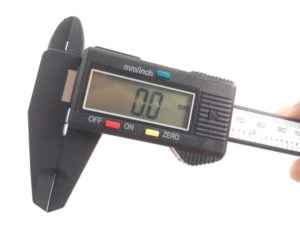
In case you are going to observe a small object’s diameter with high accuracy and precision, you need this tool. The caliper can measure with resolution until 0.01 millimeters. You can perform outside and inside and even depth measurements with this measuring instrument.
If you are going to measure the outside diameter of a tube, use the outside measurement (the larger jaws). Whereas, if you are going to measure the inside diameter, use the smaller jaws and this stuff can perform expectedly. That said, it’s three in one where you can also measure the depth of that tube. It’s strongly complete.
There are three types of calipers: vernier calipers, dial calipers, and digital calipers. You can choose which one is convenient for your measuring needs.
7. Wheel Measure
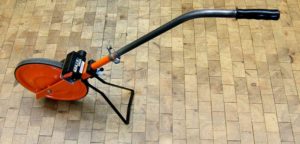
You are a surveyor that wants to measure the distance of two separated points on open land, you can use a wheel measure or odometer. Simply, we utilize its wheel diameter for the measurement. If the wheel spins 3 times; and the diameter of the wheel is 1 meter; then the total distance the wheel measure has passed is (3 × 3.14 × 1 = 9.42 m) 9.42 meters. This is equivalent to the formula of circle circumference. To ensure that you measure a linear length, the path must have a flat surface.
8. Odometer
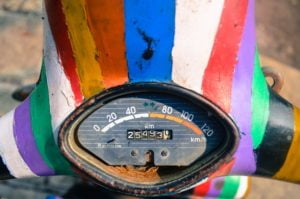
The same concept is also implemented in the odometer that functions to measure distance using a wheel. An odometer is always found in vehicles. It’s designed to measure how far the vehicle has passed through.
9. Rangefinder
A rangefinder is the friend of hunters, navigators, and also for military purposes. If you are going to measure a long displacement from your position to a specific point you are targeting, then you need this one. One incredible benefit of a rangefinder is its ability to range from a far-away target without contacting it. So it benefits you in some situations.
10. Feeler Gauge
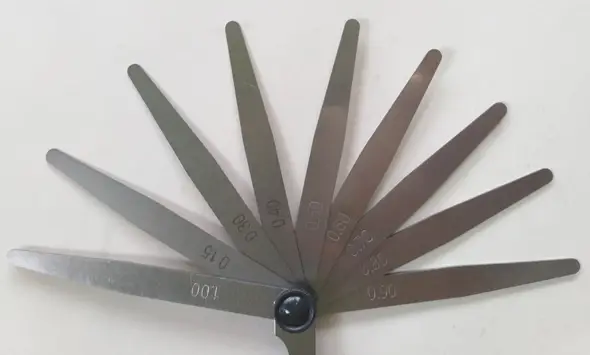
It’s difficult to measure a gap precisely with a ruler. Also, it’s not recommended to measure it with a tape measure or even a block gauge. This is the use of a feeler gauge. It’s designed to measure the gap thickness accurately. All you have to do is inserting one of the blades into the gap you are going to measure. Try one by one until you think it’s the right thickness. In the case of measuring gaps, you must use the best feeler gauge. If the blade thickness is inaccurate or the material is easy to rust, the measurement can be misleading. Also, you have to regularly check the accuracy by using a micrometer.
11. Paint Thickness Gauge
Still regarding thickness measurement, but this one is more challenging. To measure the thickness of the coating or paint, you only have one side. There are no two sides that allow you to use a micrometer or caliper. This is called a paint thickness gauge. Mount the probe to the surface, and let the tool measure. The paint thickness gauge is commonly applied to car paint. By means of this tool, the condition of the car can be evaluated.
12. Micrometer
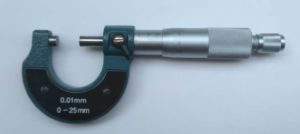
Like the caliper, the micrometer is intended for more accuracy and precision measurement. If you are not satisfied yet with the accuracy of the caliper, then turn to a micrometer.
However, you need to remember that it can only support one type of measurement. There cannot be done three types of measurements in one tool like the caliper.
If you are going to measure the thickness of a piece of paper with extreme accuracy, then this tool can do it. Especially the digital micrometer with no rotating spindle, it provides a quick reading to measure the paper thickness. If you are willing to have an inside diameter of a tube measured, you can do it with a micrometer as well but you need to find the other type of micrometer (inside micrometer). This causes you to buy more than one tool for a different type of measurement.
There are several fields that benefit from micrometers such as engineering, engine building, metalworking, and even reloading. When it comes to measuring accurately with a micrometer, the anvil is the key. Therefore, you need a replaceable anvil micrometer, or you end up buying several models of micrometers.
13. Skinfold Caliper
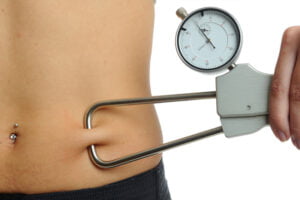 You can’t forget this one. This is an important tool for those who want to track down their workout progress to see whether there is a weight loss or not. You also can use this to measure your body weight gain. This skinfold caliper is unique. It’s designed to reach the skin in a particular small spot area in order to measure accurately. The pressure that is given can affect measurement accuracy. There are several spots on the body that you have to measure before getting the final measurement result.
You can’t forget this one. This is an important tool for those who want to track down their workout progress to see whether there is a weight loss or not. You also can use this to measure your body weight gain. This skinfold caliper is unique. It’s designed to reach the skin in a particular small spot area in order to measure accurately. The pressure that is given can affect measurement accuracy. There are several spots on the body that you have to measure before getting the final measurement result.
14. Tire Tread Depth Gauge
This is actually a depth gauge. But it has some modifications to match the need for measuring the depth of tire tread. Therefore, the maximum range of tire tread depth gauge is no more than 1 inch. It’s a simple, small, yet important tool to have in your vehicle storage. Inspect regularly your tire in order to avoid unexpected incidents due to slippy tires.
15. Altimeter
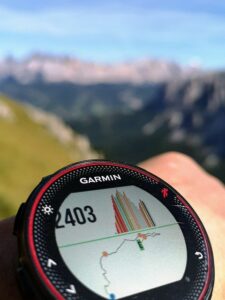 An altimeter functions to measure an altitude of a particular object over the sea level. It is one of the critical instruments for navigation in an aircraft. Why is it important to measure the altitude for aircraft navigation? A height of a certain level is equal to the air pressure at that level. If the density altitude at that level is high, the aircraft get the chance not able to take off.
An altimeter functions to measure an altitude of a particular object over the sea level. It is one of the critical instruments for navigation in an aircraft. Why is it important to measure the altitude for aircraft navigation? A height of a certain level is equal to the air pressure at that level. If the density altitude at that level is high, the aircraft get the chance not able to take off.
In addition to the purpose of this instrument, an altimeter is important in hiking, mountaineering, skydiving, etc.
There are some models of altimeter available on the market. Each of them is designed based on the requirements and comes with different features. For outdoors, an altimeter has to be designed with a durable body. It has to pass some water and dust ingress. While for a car, it has to be mounted and easy to read. Similar things come to other purposes of using this measuring tool.
16. Dial Indicator
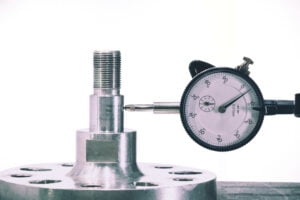 If you have a workshop and deal with milling or lathe machine, you are going to use dial indicator and dial test indicator. These two precision measuring tools are used in metalworking and woodworking to measure roundness, flatness, and squareness. For example, when the chuck rotates, the object being clamped will rotate, using a dial indicator lets us know of how round it is.
If you have a workshop and deal with milling or lathe machine, you are going to use dial indicator and dial test indicator. These two precision measuring tools are used in metalworking and woodworking to measure roundness, flatness, and squareness. For example, when the chuck rotates, the object being clamped will rotate, using a dial indicator lets us know of how round it is.
As the name tells, the reading display is a dial display like a dial caliper. You can find it in a digital indicator model as well. On the display, there are two needles. One needle functions as the revolution counter, while the second needle functions as the increment counter. This dial indicator is able to measure down to 0.001″ increment (resolution) while the test indicator is deeper resolution.
17. Dial Bore Gauge
Dial bore gauge lets you measure the inside diameter of a cylinder bore with a high degree of accuracy. It’s faster than a telescopic bore gauge. The use range is limited. It’s used primarily in engine building when you are facing the bore and stroke dimension.
Using a dial bore gauge means you are using the dial indicator as well. It’s the display of the bore gauge. However, you can find the digital indicator also can be attached as the display.
The dial bore gauge will give you extreme accuracy and helps you with an excellent resolution. In this case, you need to purchase the best dial bore gauge from the reliable one as this is commonly used for business. Even further, you need to calibrate it to make sure everything is accurate as expected.
18. Underground Cable Wire Locator
Actually, an underground cable wire locator is designed to locate underground cable or wire lines. Since it comes with depth reading, it means it can measure the depth of those wire or cable lines buried, we included it here. Unlike a wall wire locator, an underground wire locator comes with a depth reading. So, when you dig, you can estimate when to stop. This detecting instrument helps you to avoid destroying the cable lines.
Last but not Least
We’ve seen a variety of linear measuring tool models in this post. They all have different special advantages and features from each other. According to their limited functions, we have to understand what type is convenient to use for a specific condition. Not all length measuring tools can serve better precision; similarly, not all can measure a long distance. Linear measuring tools are everywhere around us. We use them and they are very useful in our life.


I love this post! It has given me so many new measurement tools to use in my work.